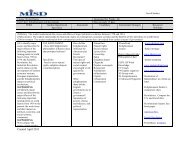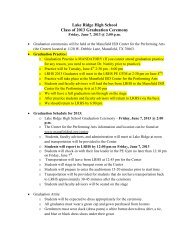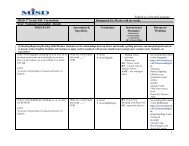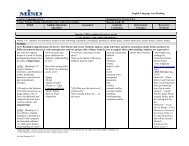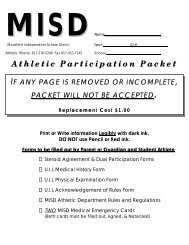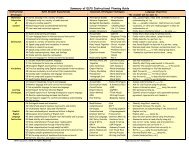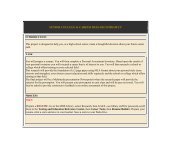Lab and graphs Cells Plant cell Prokaryotic and Eukaryotic Cells:
Lab and graphs Cells Plant cell Prokaryotic and Eukaryotic Cells:
Lab and graphs Cells Plant cell Prokaryotic and Eukaryotic Cells:
You also want an ePaper? Increase the reach of your titles
YUMPU automatically turns print PDFs into web optimized ePapers that Google loves.
DNA;<br />
T match with A<br />
C match with G<br />
Replication<br />
DNA<br />
Troy Aikman<br />
Go Cowboys<br />
The double‐str<strong>and</strong>ed DNA molecule has<br />
the unique ability that it can make exact<br />
copies of itself.<br />
RNA<br />
RNA contains the bases adenine (A), cytosine (C) <strong>and</strong><br />
guanine (G); however, RNA does not contain thymine,<br />
instead, RNA's 4th nucleotide is the base Uralic (U)<br />
U match with A C match with G<br />
• Transcription‐‐The synthesis of messenger RNA from a<br />
DNA template.<br />
• Translation‐‐The synthesis of a protein in the ribosome<br />
from a messenger RNA template.<br />
Mutation = A change in the DNA of an organism. Classified<br />
as insertion (addition of a base), deletion (subtraction of a<br />
base), or substitution (replacement of one base with<br />
another).<br />
Systems<br />
Circulatory<br />
Function: to transport blood to every part of the body.<br />
In the blood are all of the necessary gases, nutrients,<br />
<strong>and</strong> waste<br />
Digestive<br />
Function: to digest food <strong>and</strong> provide vital nutrients to<br />
the body. Eliminate wastes.<br />
Nervous<br />
Function: controls all bodily activities.<br />
Endocrine<br />
Function: secrete hormones<br />
Reproductive<br />
Function: to perpetuate the species through<br />
reproduction.<br />
Integumentary (skin)<br />
Function: regulating your body temperature, serves as a<br />
protective layer to the underlying tissues.<br />
Skeletal<br />
Function: provides a framework for the tissue of the<br />
body, protects the upper organs, muscles are anchored<br />
to the bones to allow for movement, produce blood<br />
<strong>cell</strong>s, <strong>and</strong> store vital minerals.<br />
Respiratory<br />
Function: provide the body with oxygen, <strong>and</strong> also to<br />
dispel carbon dioxide from the body.<br />
Muscular<br />
Function: Smooth muscle allows for the contraction of<br />
organs (moves food along the intestines) <strong>and</strong> blood<br />
vessels (pushes blood through). Cardiac muscle is<br />
responsible for the pumping of the heart. Skeletal<br />
muscle allows for all movement of the body.<br />
Excretory/Urinary<br />
Function: filter the blood <strong>and</strong> remove major waste<br />
products such as ammonia <strong>and</strong> urea.<br />
Immune/Lymphatic<br />
Function: protect the body from infections <strong>and</strong><br />
antigens.<br />
mRNA fragment that was originally CUU what amino acid is<br />
produced?




